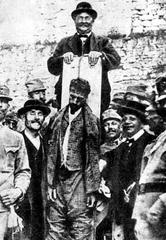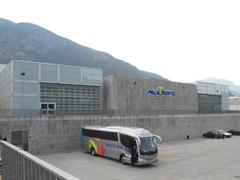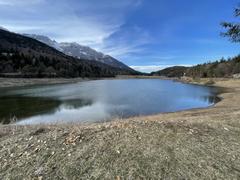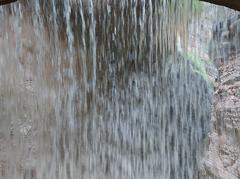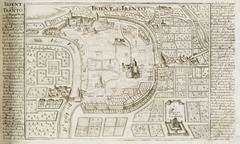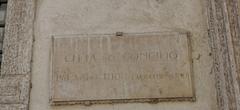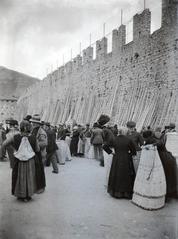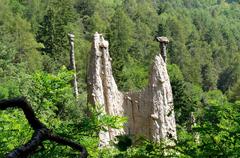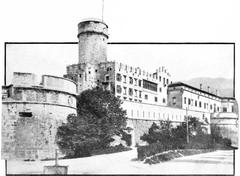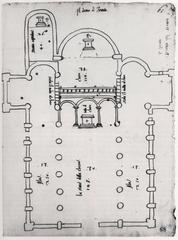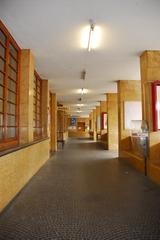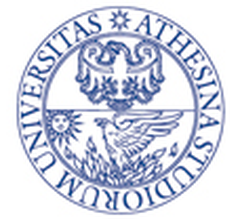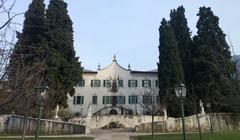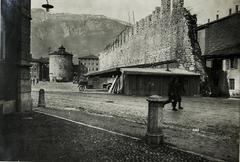Visiting Castel Belfort in Trento, Italy: Tickets, Hours, and Tips
Date: 19/07/2024
Introduction
Nestled in the Non Valley of Trento, Italy, Castel Belfort is a captivating historical site that beckons travelers with its rich past and stunning architectural features. This medieval fortress, originally constructed in 1311 by Tissone di Castelcampo, has witnessed centuries of history, from its strategic military importance in the Middle Ages to its Renaissance transformation under the Counts of Thun. Whether you are a history enthusiast, architecture lover, or curious traveler, Castel Belfort offers a unique glimpse into the cultural heritage of the Trento region. With its imposing towers, panoramic views, and well-preserved ruins, the castle stands as a testament to the region’s evolving historical landscape. Visitors can explore the site’s extensive history, partake in guided tours, and enjoy various cultural events that bring the past to life.
For more details, visit the official Castel Belfort website or the Trentino tourism website.
Table of Contents
- [Historical Overview](#historical-overviewhistorical-overview)
- [Early Beginnings and Construction](#early-beginnings-and-constructionearly-beginnings-and-construction)
- [Medieval Expansion and Fortifications](#medieval-expansion-and-fortificationsmedieval-expansion-and-fortifications)
- [The Renaissance Influence](#the-renaissance-influencethe-renaissance-influence)
- [The 17th Century - A Period of Decline](#the-17th-century---a-period-of-declinethe-17th-century-a-period-of-decline)
- [The 18th and 19th Centuries - Abandonment and Neglect](#the-18th-and-19th-centuries---abandonment-and-neglectthe-18th-and-19th-centuries-abandonment-and-neglect)
- [20th Century - Restoration and Preservation](#20th-century---restoration-and-preservation20th-century-restoration-and-preservation)
- [Modern-Day Significance](#modern-day-significancemodern-day-significance)
- [Architectural Highlights](#architectural-highlightsarchitectural-highlights)
- [Cultural and Historical Exhibits](#cultural-and-historical-exhibitscultural-and-historical-exhibits)
- [Visitor Information](#visitor-informationvisitor-information)
- [Visiting Hours](#visiting-hoursvisiting-hours)
- [Ticket Prices](#ticket-pricesticket-prices)
- [Special Events](#special-eventsspecial-events)
- [Guided Tours](#guided-toursguided-tours)
- [Travel Tips and Nearby Attractions](#travel-tips-and-nearby-attractionstravel-tips-and-nearby-attractions)
- [FAQ](#faqfaq)
- [Conclusion](#conclusionconclusion)
- [References](#referencesreferences)
Historical Overview
Early Beginnings and Construction
Castel Belfort, located in the picturesque region of Trento, Italy, has a rich history dating back to the 14th century. The castle was initially constructed in 1311 by Tissone di Castelcampo, a nobleman from the region. The strategic location of Castel Belfort, nestled in the Non Valley, was chosen for its defensive advantages, providing a vantage point over the surrounding area. The original structure was relatively modest, consisting of a central keep and a few ancillary buildings.
Medieval Expansion and Fortifications
Throughout the 14th and 15th centuries, Castel Belfort underwent significant expansions and fortifications. The castle’s strategic importance grew, prompting successive owners to enhance its defensive capabilities. High walls, battlements, and additional towers were constructed to protect against potential invaders. The castle’s architecture during this period reflected the typical medieval style, with thick stone walls and narrow windows designed for archers.
The Renaissance Influence
The Renaissance period brought about a transformation in the architectural style and function of Castel Belfort. In the 16th century, the castle was acquired by the Counts of Thun, a prominent noble family in the region. Under their ownership, the castle was renovated to reflect the Renaissance aesthetic, incorporating more elegant and refined elements. The interior was adorned with frescoes, intricate woodwork, and decorative stone carvings, showcasing the artistic trends of the time.
The 17th Century - A Period of Decline
The 17th century marked a period of decline for Castel Belfort. The castle suffered significant damage during the Thirty Years’ War (1618-1648), a devastating conflict that ravaged much of Europe. The once-mighty fortress was partially destroyed, and many of its defensive structures were left in ruins. Despite efforts to repair the damage, the castle never fully regained its former glory.
The 18th and 19th Centuries - Abandonment and Neglect
By the 18th century, Castel Belfort had fallen into a state of disrepair. The castle was abandoned by its noble owners, who moved to more modern and comfortable residences. Over the next century, the castle was left to the elements, and its condition deteriorated further. Local legends and folklore began to surround the castle, adding to its mystique and allure.
20th Century - Restoration and Preservation
The 20th century saw a renewed interest in preserving Castel Belfort as a historical monument. In the early 1900s, efforts were made to stabilize the remaining structures and prevent further decay. The castle was recognized for its historical and cultural significance, leading to more comprehensive restoration projects in the latter half of the century. These efforts aimed to preserve the castle’s unique architectural features and make it accessible to the public.
Modern-Day Significance
Today, Castel Belfort stands as a testament to the rich history and cultural heritage of the Trento region. The castle is a popular tourist destination, attracting visitors from around the world who come to explore its ancient ruins and learn about its storied past. The site offers guided tours, educational programs, and cultural events, providing a comprehensive experience for history enthusiasts and casual visitors alike.
Architectural Highlights
One of the most striking features of Castel Belfort is its central keep, which remains largely intact despite the passage of centuries. The keep offers panoramic views of the surrounding Non Valley, allowing visitors to appreciate the strategic importance of the castle’s location. The castle’s walls and towers, though partially ruined, still convey a sense of the formidable defenses that once protected the fortress.
Cultural and Historical Exhibits
Inside the castle, several rooms have been restored and converted into exhibition spaces. These exhibits showcase artifacts and historical documents related to the castle’s history, providing valuable insights into the lives of its former inhabitants. Visitors can view medieval weaponry, Renaissance art, and other items that illustrate the castle’s evolution over the centuries.
Visitor Information
Visiting Hours
Castel Belfort is open to the public year-round, with varying hours depending on the season. During the summer months, the castle typically opens from 9 AM to 7 PM, while in the winter, visiting hours are reduced from 10 AM to 5 PM.
Ticket Prices
Admission fees are modest, with adult tickets priced at €8, children (ages 6-12) at €4, and free entry for children under 6. Discounts are available for groups and seniors.
Special Events
The castle hosts special events, such as medieval reenactments and cultural festivals, which offer a unique and immersive experience for visitors. Check the official website for the latest event schedules.
Guided Tours
Guided tours are available in multiple languages, providing in-depth information about the castle’s history and architecture. Tours typically last about 1.5 hours and can be booked in advance.
Travel Tips and Nearby Attractions
Castel Belfort is easily accessible by car, with ample parking available on site. For those using public transportation, local buses run regularly from Trento to the Non Valley. Nearby attractions include the Thun Castle and the Sanctuary of San Romedio, making it easy to plan a full day of exploration in the region.
FAQ
What are the opening hours of Castel Belfort?
Castel Belfort is open year-round, with summer hours from 9 AM to 7 PM and winter hours from 10 AM to 5 PM.
How much are tickets for Castel Belfort?
Adult tickets are €8, children (ages 6-12) are €4, and children under 6 enter for free. Discounts are available for groups and seniors.
Are guided tours available?
Yes, guided tours are available in multiple languages and can be booked in advance.
What events are held at Castel Belfort?
The castle hosts medieval reenactments, cultural festivals, and other special events. Check the official website for the latest event schedules.
For more information on visiting Castel Belfort, including current hours and event schedules, please visit the official Castel Belfort website.
Conclusion
Castel Belfort is more than just a historical monument; it is a journey through time that reflects the rich cultural and architectural heritage of the Trento region. From its medieval origins and Renaissance transformations to its 20th-century restoration efforts, the castle encapsulates the dynamic history of Italy. Today, Castel Belfort stands as a cherished historical site, attracting visitors from around the world who come to explore its ruins, enjoy guided tours, and participate in cultural events. With its strategic location, architectural marvels, and immersive visitor experience, Castel Belfort offers a captivating and educational experience for all. Whether you are delving into the castle’s storied past or simply enjoying the picturesque surroundings, a visit to Castel Belfort is sure to leave you with lasting memories and a deeper appreciation for Italy’s historical and cultural legacy.
For the latest updates on visiting hours, ticket prices, and special events, check the official Castel Belfort website or the Trentino tourism website.
References
- Castel Belfort - A Historical Gem in Trento - Visiting Hours, Tickets, and More, 2024. https://www.castelbelfort.it
- Castel Belfort - Visiting Hours, Tickets, and Historical Insights in Trento, 2024. https://www.visittrentino.info/en
- Essential Visitor Tips for Castel Belfort - Admission, Accessibility, and Nearby Attractions, 2024. https://www.visittrentino.info/en/guide/attractions/castel-belfort_md_2293

